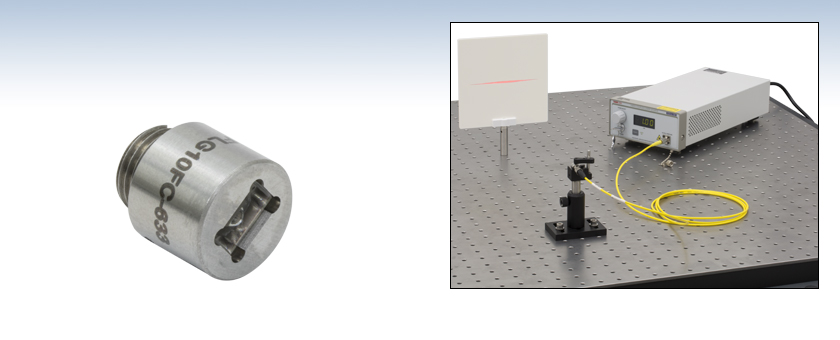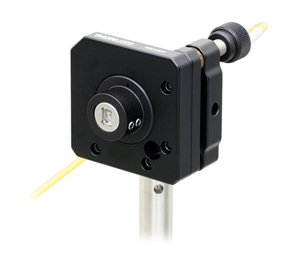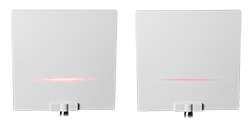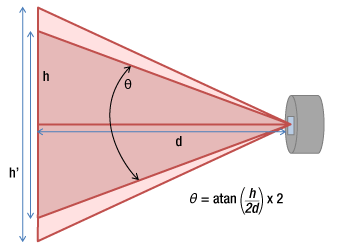Laser Line Generator: 633 nm, FC/PC Connector

- Produce a Diverging Laser Line
- Cylindrical Lens Factory Aligned at 633 nm
- Custom Options Available
FLG10FC-633
Laser Line Generator, 633 nm
FLG10FC-633 Laser Line Generator in a VC1 V-Clamp Connected with a P1-630AR-2 Patch Cable to an S1FC635 Laser Source

Please Wait

Click to Enlarge
Figure 1.2 An FLG10FC-633 line generation package is secured in a KM100T Mirror Mount using an AD11F Collimator Mounting Adapter.

Click to Enlarge
Figure 1.1 The FLG10FC-633 Used to Produce Laser Lines from Single Mode (Left) and Multimode (Right) Fiber; Note the Reduced Intensity in the Right Image
Features
- Line Generator for Single Mode Patch Cables with FC/PC Connectors
- Factory Aligned at 633 nm Wavelength
- Non-Magnetic Ø11 mm Stainless Steel Housing
- Compatible with Narrow and Wide Key FC/PC Connectors
- Custom Options, Including Custom Alignment, Available by Contacting Tech Support
This fiber laser line generator is pre-aligned to produce a diverging line of light at 633 nm from an FC/PC-terminated single mode fiber. Because this fiber component has no movable parts, it is compact and easy to integrate into an existing setup. The cylindrical lens within the package collimates the output of a single mode fiber in one dimension, resulting in a diverging line output with a Gaussian intensity profile. The line generator produces a theoretical 23° full-angle divergence for light at the design wavelength and a fiber with a mode field diameter (MFD) of 4.3 µm. The actual divergence angle of a laser line will depend on the fiber NA and the wavelength of the light; please see the Divergence Info tab for more detail.
The cylindrical lens within this line generator has an AR coating on both sides that minimizes surface reflections from 350 nm to 700 nm. For some applications, this line generator can be used at wavelengths within the AR coating range other than the design wavelength. Please note that this package is not vacuum compatible and that the operating temperature of the line generator is -40 °C to 93 °C. Line generators with custom alignment, operating temperature, or vacuum compatibility are available by contacting Technical Support.
We recommend using this line generator with our AR-coated single mode fiber optic patch cables. These cables feature an antireflective coating on one fiber end for increased transmission and improved return loss at the fiber-to-free-space interface. Alternatively, our large selection of standard single mode fiber patch cables can also be used with this line generator. We do not recommend the use of multimode patch cables. Our S1FC635 Benchtop Fiber-Coupled Laser and KLS635 K-Cube® Laser are ideal light sources for use with this component. The laser-induced damage threshold of a system using this line generator with a single mode fiber will typically be limited by the fiber.
The stainless steel housing for this line generator package is unthreaded and has an 11 mm diameter. An engraved line on the side of the housing indicates the orientation of the laser line generated by the package. To mount the line generator package, we recommend using one of our fixed or kinematic collimator mounting adapters for unthreaded Ø11 mm components, which are available with unthreaded 1/2" and 1" diameters or external SM1 (1.035"-40) threads.
For applications requiring a flat-top laser line profile, consider our line of Powell lenses.
| Item # | Design Wavelength |
Design MFDa | Output Fan Angle (1/e2)b | Output Fan Angle (99%)b | Line Width Divergence Angle (1/e2)b | AR Coating (Click for Graph)c | Included Lens | Focal Length | Housing Diameter | Suggested Adapters |
|---|---|---|---|---|---|---|---|---|---|---|
| FLG10FC-633 | 633 nm | 4.3 µm | 15.2° | 23° | 0.04° | 350 - 700 nm | LJ1918L1-A | 5.8 mm | 11 mm | AD11BA, AD11NT, KAD11NT, AD11F, KAD11F |

Click to Enlarge
Figure 2.2 Diagram Illustrating the Diverging Laser Line from a Line Generation Package
| Table 2.1 Divergent Line Length | ||
|---|---|---|
| Distance (d) | 1/e2 Line Length (h) | 99% Line Length (h') |
| 125 mm | 33.5 mm | 50.9 mm |
| 250 mm | 66.9 mm | 101.7 mm |
| 500 mm | 133.9 mm | 203.5 mm |
| 1000 mm | 267.7 mm | 406.9 mm |
| 1500 mm | 401.6 mm | 610.4 mm |
The fiber-coupled line generation package includes a cylindrical lens that collimates the output of a single mode fiber in one dimension. This results in a divergent line output with a Gaussian intensity profile. When used with light at 633 nm and a fiber with a mode field diameter (MFD) of 4.3 µm, the 1/e2 power full angle divergence of the line is 15.2°. With these parameters, the length of the line (defined as containing either 1-1/e2 or 99% of the optical power) is given at five distances in Table 2.1. The length of the line containing 99% of the optical power is 1.52X the length of the line containing 1-1/e2 of the optical power.
If a different single mode fiber is used with this line generator, the divergence angle of the laser line will differ. More specifically, the 1/e2 divergence angle can be calculated from the numerical aperture (NA) of the fiber, according to equation:

| Posted Comments: | |
ikram khan
(posted 2025-02-17 12:19:19.623) I need this for 520 nm line generation. cdolbashian
(posted 2025-02-26 11:34:06.0) Thank you for reaching out to us with this request! For different wavelengths, but similar angular spread, we can easily make this as a custom for you! I have reached out to you directly to discuss this. For future custom requests, please feel free to contact our custom team directly using Techsales@thorlabs.com. Daniel Headland
(posted 2024-07-11 10:03:49.553) Do you think that it will work with a telecom-wavelength laser (1550nm)? If so, what kind of beam divergence should we expect from the optic, and what kind of reflectance from the antireflection coating?
Is it possible to order a custom telecom-wavlelength version of this product?
This is the same as phill's inquiry from 2017 ksosnowski
(posted 2024-07-11 01:14:49.0) Hello Daniel, thank you for reaching out to us. This should be possible to make using our lens LJ1918L1-C instead. The page for this lens has the full reflection plots for the -C (1050nm-1700nm) AR coating, approximately 0.09% at 1550nm. The divergence of a collimated fiber output tend to be slightly greater at longer wavelengths however it is directly related to the MFD of the fiber used. Our line generator was designed with SM600 with MFD close to 5um. Larger MFD fibers will have proportionally higher output divergence when aligned with this optic. I have reached out directly to discuss your application in further detail. Dion Engels
(posted 2024-05-27 15:32:46.82) Dear Thorlabs,
I've been using this FLG10FC-633 for a few days with my HeNe laser (HNL225R). However, I see a weird beating in my power output, sometimes with a period in the minutes, but also sometimes with a period of around 5 seconds (both cases 1 mW oscillation on ~10 mW). I've tried using M64L01 and P1-630A-FC-5 fibers. Both of these are FC/PC. I was wondering if the oscillations could be due to back reflections, and if so, if you have an APC variant of the FLG10FC-633.
Thanks! jpolaris
(posted 2024-07-12 06:34:38.0) Thank you for contacting Thorlabs. If you are observing power fluctuations only when FLG10FC-633 is being used, then this very well could be due to back-reflections. Changes in temperature, mechanical stress on the HNL225R housing, and back-reflections can all impact stability. As the HeNe tube warms up, it undergoes small changes to its shape. These small changes can impact the cavity modes of the laser, and thus also the stability. I have reached out to you directly to assist in diagnosing this issue, as well as to discuss offering an APC variant of FLG10FC-633. akihiro shiokawa
(posted 2022-11-29 20:22:29.763) はじめまして。
日産自動車 塩川と申します
FLG10FC-633の商品ですが、850nmでのカスタマイズは可能でしょうか。
よろしくお願いいたします。 cdolbashian
(posted 2022-12-02 04:29:54.0) Thank you for contacting us with this inquiry. Your local office has reached out to you to discuss this type of custom. To discuss future potential customs, please contact your local office: in this case Techsupport.jp@thorlabs.com. moti yanuka
(posted 2021-03-09 19:08:03.493) I am looking for a line laser length 20-30 mm width 5 microns YLohia
(posted 2021-03-09 11:29:47.0) Thank you for contacting Thorlabs. Unfortunately, we don't have an off-the-shelf version of the FLG10FC-633 to accomplish this. I have reached out to you directly to discuss this further. Vincent Hahn
(posted 2019-08-06 06:41:30.633) Dear Ladies and Gentlemen,
I wonder why the Powell-Lenses have been discontinued. Has this decision been for technical limitations of those lenses?
Thank you
Vincent Hahn YLohia
(posted 2019-08-06 04:25:27.0) Hello Vincent, thank you for contacting Thorlabs. I have reached out to you directly to discuss your question. igkiou
(posted 2018-04-05 21:08:42.38) Hi,
Do you provide an FC/PC-packaged line generator with a larger fan angle?
There used to be a few Powel lenses with up to 75 degrees fan angle (PL0175), but those were isolated lenses without the FC/PC connector packaging.
It would be very helpful if there were an FC/PC-packaged line generator that reached 75 degrees fan angle.
Thank you in advance for your help. YLohia
(posted 2018-04-06 12:30:56.0) Response from Yashasvi at Thorlabs USA: Hello, thank you for your feedback. The current iteration of these line generators have a single cylindrical lens, which collimated the light in one direction (the "thin" side of the line) while letting the light freely diverge in the other direction (along the "length" of the line). Thus, the fan angle is directly dependent on the NA of the fiber. The 1/e^2 output fan angle spec of 15.2° is specifically for our SM600 fiber that has an NA of 0.10 – 0.14. So we are not able to offer custom versions with various fan angles at this time. You can, however, still use one of these in conjunction with one of our concave cylindrical lenses to diverge the light further along the length of the line. phill
(posted 2017-08-28 22:52:46.767) Line generator FLG10FC-633 seems to be optimally designed for 633 nm.
I would like to know if this can be used with a wavelength 1550 nm also.
If yes, please let me know the beam angle of line with some other related parameters.
Hope to receive your reply. tfrisch
(posted 2017-08-31 10:32:23.0) Hello, thank you for contacting Thorlabs. I will reach out to you directly with information for a quote. mgg6
(posted 2016-05-24 14:24:01.293) Combining something like this with a few mode laser diode (such as Thorlabs L450P1600MM or L638P700M) would produce a much more effective line generator, since multimode lasing along the line axis would suppress speckle without increasing the beam divergence in the perpendicular axis. besembeson
(posted 2016-05-25 05:01:28.0) Response from Bweh at Thorlabs USA: It seems to me this will be the case since the input will be less coherent. We will also subsequently test this. user
(posted 2016-03-23 14:30:32.983) Is other wavelength available, like 540 nm? besembeson
(posted 2016-03-24 11:56:31.0) Response from Bweh at Thorlabs USA: At 540nm, the throughput should be good, due to the broadband AR coating on the line generator. The divergence angle will be different as we explain under the "Divergence Info" tab here: http://www.thorlabs.com/NewGroupPage9.cfm?ObjectGroup_ID=9344. So depending on your application, with an AR coated fiber for 540nm, this may still be suitable. |
 Products Home
Products Home














 Line Generation Package
Line Generation Package